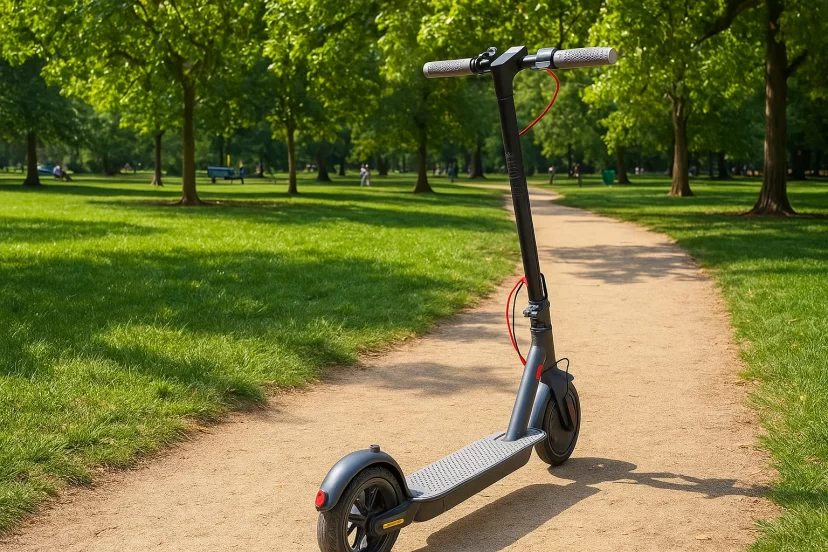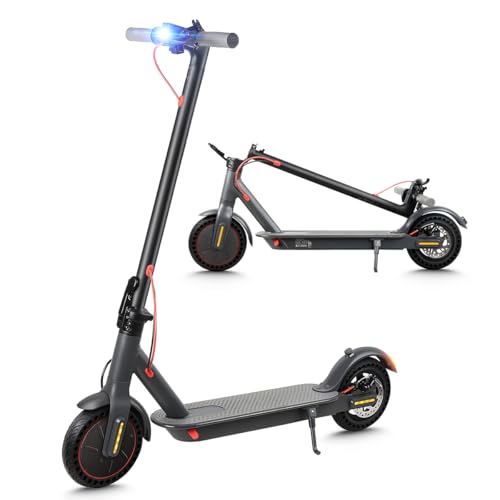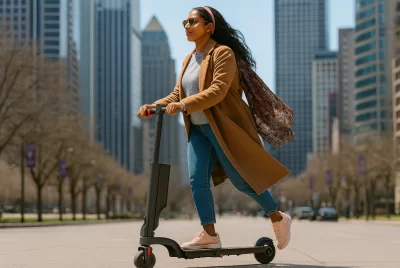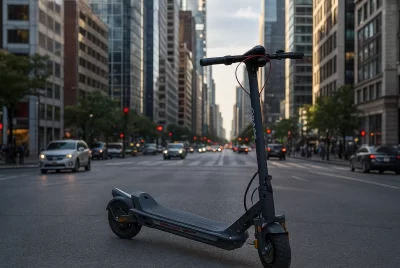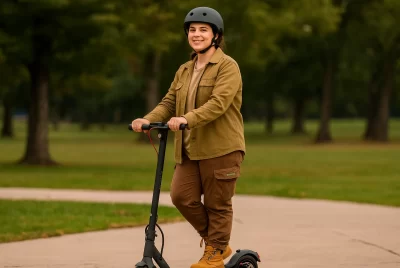Mankeel Electric Scooter Review
*We may earn a commission for purchases made using our links. Please see our disclosure to learn more.
The morning commute doesn’t have to be a battle against traffic, crowded public transport, or the frustration of circling for parking. Picture this: gliding through city streets with the wind in your hair, arriving at your destination energized rather than exhausted, all while making an eco-conscious choice. This is the promise of the Mankeel electric scooter, and for countless urban commuters, it has become more than just transportation—it’s a lifestyle transformation.
“The electric scooter revolution isn’t just about getting from point A to point B—it’s about reclaiming your time, reducing your environmental footprint, and rediscovering the joy of moving through your city on your own terms.”
— Urban Mobility Research Institute, 2024
Key Takeaways
- Versatility Meets Performance: Mankeel electric scooters offer powerful motors, impressive range, and robust build quality suitable for various terrains
- Cost-Effective Transportation: Significant savings on fuel, parking, and maintenance compared to traditional vehicles
- Eco-Friendly Commuting: Zero emissions contribute to cleaner urban environments
- Practical Features: Foldable designs, multiple speed modes, and advanced safety features enhance daily usability
- Health and Wellness: Reduces stress, encourages outdoor activity, and promotes a more active lifestyle
Mankeel Electric Scooter
Mankeel 350W Electric Scooter for Adults
The Mankeel Electric Scooter combines performance, convenience, and safety in one stylish ride. Equipped with a powerful 350W or 500W motor, it reaches speeds of up to 19 MPH and offers a long range of up to 21 miles—perfect for daily commuting or quick city trips. With durable 8.5” or 10” solid tires, you’ll never have to worry about flats or maintenance. Its lightweight 33-pound aluminum frame folds in seconds for easy portability. The dual braking system with drum and EABS anti-lock brakes ensures a secure stop every time, while the smartphone app allows for smart control, including lock/unlock and speed settings.
The Mankeel Electric Scooter stands out as a top choice for urban commuters and eco-conscious riders seeking a balance of power, design, and practicality. Featuring a 350W or 500W motor, it effortlessly glides through city streets at speeds of up to 19 MPH, with a range of 21 miles on a single charge. Its foldable aluminum frame and lightweight 33-pound build make it easy to carry and store, ideal for apartment living or office commutes.
- Performance: Powerful 350W/500W motor delivers up to 19 MPH speed and smooth acceleration.
- Convenience: Foldable, lightweight design with app control for locking and customization.
- Safety: Dual braking system and LED headlights enhance visibility and riding confidence.
- Range Limitation: Maximum 21-mile range may not suit long-distance travelers.
- Solid Tires: Less shock absorption compared to air-filled tires on rough terrain.
- Charging Time: Takes several hours to fully charge the battery before each long trip.
The Transformation Begins: Why Choose a Mankeel Electric Scooter
The decision to embrace electric scooter commuting often stems from a moment of frustration—sitting in gridlocked traffic, missing another train, or calculating yet another expensive ride-share fare. The Mankeel electric scooter addresses these pain points with elegance and efficiency.
Breaking Free from Transportation Constraints
Traditional commuting options come with inherent limitations. Cars trap you in traffic and demand expensive parking. Public transportation runs on schedules that rarely align perfectly with your needs. Bicycles require physical exertion that leaves you sweaty before important meetings. The Mankeel electric scooter offers a middle path: the freedom of personal transportation without the hassle of traditional vehicles.
The first ride often feels revelatory. The smooth acceleration, the quiet hum of the motor, the ability to weave through congested areas legally and safely—these elements combine to create a commuting experience that feels less like a chore and more like a choice you make for yourself.
The Environmental Impact That Matters
Climate consciousness isn’t just a buzzword; it’s a responsibility many embrace. Every Mankeel electric scooter journey represents a small but meaningful step toward cleaner air and reduced carbon emissions. A single scooter can eliminate hundreds of car trips per year, collectively contributing to significant environmental benefits.
The mathematics are compelling: a typical electric scooter consumes approximately 0.5 kWh per 25 miles, compared to a car’s 3-4 kWh equivalent for the same distance. Over a year of commuting, this translates to tons of CO2 not released into the atmosphere. For environmentally conscious riders, this isn’t just transportation—it’s activism in motion.
Overcoming Common Challenges: The Journey to Confident Riding
Challenge 1: Safety Concerns and Learning Curve
Fear of accidents or injuries often prevents potential riders from making the leap. This concern is valid and deserves thoughtful attention. The path from hesitant beginner to confident rider involves understanding both the scooter’s capabilities and your own.
The Solution: Start in controlled environments. Empty parking lots, quiet residential streets, or designated scooter paths provide ideal training grounds. Mankeel electric scooters typically feature multiple speed modes—beginning in the lowest setting allows new riders to build muscle memory and spatial awareness gradually.
Protective gear transforms anxiety into confidence. A quality helmet, wrist guards, and reflective clothing aren’t signs of weakness; they’re investments in longevity. Many riders report that their fear dissipated within the first week of consistent practice, replaced by increasing comfort and joy.
Challenge 2: Range Anxiety and Battery Management
The fear of running out of power mid-journey haunts many new electric scooter owners. Unlike gas stations on every corner, charging opportunities can seem limited, creating stress around trip planning.
The Solution: Understanding your Mankeel electric scooter’s real-world range proves essential. Manufacturer specifications assume ideal conditions—flat terrain, moderate speed, optimal temperature, and a single rider. Reality often differs. Testing your scooter’s limits during low-stakes situations builds accurate knowledge.
Developing charging routines eliminates anxiety. Most riders discover that nightly charging becomes as automatic as plugging in a smartphone. For longer journeys, mapping charging opportunities—office outlets, café stops, friend’s homes—transforms range limitations into strategic planning opportunities rather than insurmountable obstacles.
Challenge 3: Weather and Seasonal Limitations
Rain, snow, extreme heat, and bitter cold all challenge electric scooter commuting. The question isn’t whether weather creates difficulties, but how to adapt intelligently.
The Solution: Mankeel electric scooters with IP54 or higher water resistance ratings handle light rain and puddles confidently. However, heavy downpours and icy conditions demand alternative arrangements. Building a flexible transportation strategy—identifying days when backup options make sense—prevents the scooter from becoming a fair-weather toy.
Seasonal accessories extend usability. Waterproof covers protect the scooter during storage. Hand warmers and layered clothing make cold weather manageable. Summer heat requires hydration planning and sun protection. Rather than viewing weather as a barrier, experienced riders see it as an opportunity to develop resilience and adaptability.
Challenge 4: Storage and Security Concerns
Theft and vandalism represent legitimate concerns, particularly in urban environments. A Mankeel electric scooter represents significant investment, and protecting that investment requires thoughtful strategies.
The Solution: The foldable design of most Mankeel models solves many storage challenges. Bringing the scooter indoors—into offices, apartments, or secured bike rooms—eliminates most theft risks. For situations requiring outdoor parking, heavy-duty U-locks and cable combinations through both wheels and frame provide deterrence.
GPS tracking devices, available as aftermarket additions, offer recovery possibilities if theft occurs. Registering your scooter’s serial number with local authorities and online databases creates additional security layers. Insurance options specifically designed for electric scooters provide financial protection and peace of mind.
The Three Pillars of Mankeel Electric Scooter Excellence
Pillar 1: Performance That Adapts to Your Needs
The true beauty of a Mankeel electric scooter lies in its versatility. A single vehicle serves multiple purposes: leisurely weekend explorations, intense weekday commutes, quick errand runs, and even light off-road adventures with appropriate models.
Motor power determines capability. Models ranging from 350W to 1000W accommodate different needs. The 350W variants excel in flat urban environments where portability matters most. The 600W-800W middle range handles moderate hills and longer distances with comfort. The 1000W beasts conquer steep inclines and rough terrain that would challenge lesser machines.
Speed isn’t just about rushing—it’s about options. Multiple speed modes allow riders to match velocity to context. Crowded sidewalks demand cautious speeds. Open bike lanes invite exhilaration. The ability to adjust instantly makes each journey safer and more enjoyable.
Pillar 2: Build Quality That Inspires Confidence
Components matter. Cheap scooters save money initially but cost more through repairs, replacements, and eventual disposal. Mankeel’s commitment to quality materials—aircraft-grade aluminum frames, premium lithium batteries, hydraulic disc brakes—translates to longevity and reliability.
The suspension system deserves particular attention. Dual suspension models absorb road imperfections that would otherwise transfer directly to the rider’s body. Long-term comfort isn’t luxury; it’s practical necessity for anyone covering significant distances regularly. Sore backs, numb hands, and jarring joints discourage continued use faster than any other factor.
Tire selection impacts both performance and maintenance. Pneumatic tires offer superior ride quality and grip but require occasional inflation and puncture repairs. Solid tires eliminate maintenance but transmit more road vibration. Understanding this trade-off helps match scooter choice to personal priorities and local road conditions.
Pillar 3: Features That Enhance Daily Experience
Modern Mankeel electric scooters transcend basic transportation. Integrated LED lighting systems ensure visibility during dawn, dusk, and night riding. Digital displays provide real-time information on speed, battery level, distance traveled, and riding mode. Smartphone connectivity enables GPS navigation, ride statistics tracking, and remote diagnostics.
Cruise control transforms long straight stretches from thumb-fatiguing exercises into relaxed cruising. Regenerative braking extends range by converting deceleration energy back into battery charge. These details individually seem minor, but collectively they elevate the ownership experience from adequate to excellent.
The Ripple Effects: How Electric Scooter Commuting Transforms Life
Financial Freedom Through Smart Transportation
The cost analysis reveals compelling advantages. A Mankeel electric scooter typically costs between $400-$1000 initially. Electricity for charging runs approximately $5-10 monthly. Maintenance—tire replacements, brake pad changes, occasional professional servicing—averages $100-200 annually.
Compare this to car ownership: payments or depreciation, insurance, fuel, parking, maintenance, and registration easily exceed $500-800 monthly in most urban areas. Even public transportation passes typically cost $80-150 monthly. Over three years, a quality electric scooter essentially pays for itself multiple times over.
These savings enable other life enhancements: better food, educational opportunities, entertainment, savings, or debt reduction. The financial impact extends far beyond transportation, touching overall quality of life.
Mental Health Benefits of Active Commuting
The psychological shift from passive to active commuting proves profound. Sitting in cars or crowded trains positions you as cargo being transported. Riding an electric scooter makes you an active participant in your journey.
Fresh air and sunlight exposure boost vitamin D levels and regulate circadian rhythms. The light physical engagement—balancing, steering, responding to the environment—keeps the mind alert without causing stress. Many riders report arriving at work more energized and ending workdays feeling less drained.
The mindfulness aspect shouldn’t be overlooked. Unlike cars with radio distractions or trains with crowd management stress, scooter riding demands present-moment awareness. This meditation-in-motion quality provides daily mental health maintenance that many riders value as much as the transportation utility itself.
Building Community and Connection
Electric scooter riders recognize each other—a nod, a wave, a quick conversation at charging stations. This informal community provides social connection in increasingly isolated urban environments. Online forums, local meetup groups, and social media communities offer spaces to share tips, routes, and experiences.
Group rides organized through apps or local clubs transform solo commuting into social events. Weekend explorations with fellow enthusiasts reveal hidden neighborhood gems and create lasting friendships. The shared experience of embracing alternative transportation creates bonds that transcend the activity itself.
Practical Wisdom for Maximizing Your Mankeel Experience
Maintenance Routines That Prevent Problems
Consistent basic care extends scooter life dramatically. Weekly inspections take five minutes: check tire pressure, test brakes, ensure all bolts remain tight, examine cables for wear, and clean accumulated debris. Monthly deeper maintenance includes lubricating moving parts, inspecting brake pads for wear, and cleaning electrical connections.
Battery care determines long-term performance. Avoid complete discharges when possible—maintaining charge between 20-80% optimizes battery longevity. Store in moderate temperatures; extreme heat or cold degrades battery chemistry. Use the manufacturer’s charger exclusively; third-party alternatives may lack proper voltage regulation.
Not all paths serve electric scooters equally. Ideal routes prioritize dedicated bike lanes, smooth pavement, minimal stop-and-go traffic, and appropriate width for safe passing. Mapping applications with bicycle-specific routing often identify scooter-friendly paths better than standard driving directions.
Learn local regulations. Some cities restrict scooter use on sidewalks; others prohibit road riding. Speed limits, helmet requirements, and age restrictions vary by jurisdiction. Ignorance doesn’t excuse violations, and fines can be substantial. Responsible riding protects both individual safety and the broader reputation of electric scooter users.
Customization and Upgrades
Mankeel electric scooters accept numerous aftermarket enhancements. Upgraded grips improve comfort during long rides. Additional lighting increases visibility. Phone mounts enable navigation without dangerous handheld device use. Mirrors provide rear visibility without constant head-turning.
Some riders install upgraded suspension components for even smoother rides. Others add custom paint or decals for personalization. Bell or horn upgrades ensure pedestrians hear your approach. Lock mounting systems keep security hardware conveniently accessible. These modifications transform a good scooter into your perfect scooter.
Addressing Different Riding Scenarios
The Daily Commute
Consistency builds efficiency. Establish a departure routine: check battery charge, verify tire pressure, confirm all lights function, secure any cargo. The five-minute pre-flight check prevents most mid-journey surprises.
Dress appropriately for arrival, not just the ride. Layering allows temperature adjustment. Backpacks or mounted bags keep hands free and weight distributed. Reflective elements scattered across your outfit create visibility from multiple angles.
Weekend Adventures and Recreation
Beyond utilitarian commuting, Mankeel electric scooters enable exploration. Those 40-50 mile ranges open entire metropolitan areas to casual touring. Parks, waterfronts, historic districts, and scenic routes become accessible without parking hassles or physical exhaustion.
Pack essentials: basic tool kit, portable pump, first aid supplies, extra charged power bank for phone emergencies, water, and snacks. Plan routes with potential charging opportunities identified. Share your route with someone for safety.
Multi-Modal Transportation Integration
Electric scooters shine brightest when combined with other transportation modes. Ride to the train station, fold the scooter, continue via rail, then ride the final miles to your destination. This flexibility eliminates the “last mile” problem that makes public transportation impractical for many.
Familiarize yourself with local transit rules regarding scooters. Some systems require folded scooters during peak hours. Others restrict battery sizes. Understanding these regulations prevents unpleasant surprises and enables smooth multi-modal journeys.
Inclement Weather Strategies
Experienced riders develop weather-specific techniques. Light rain? Reduce speed by 30%, extend following distances, avoid painted road markings and metal surfaces, and expect longer braking distances. Heavy rain? Skip the ride unless absolutely necessary.
Cold weather demands battery awareness—lithium batteries lose capacity in freezing temperatures. Start with a fully charged battery, keep it warm when possible, and expect reduced range. Dress warmer than you think necessary; wind chill on a moving scooter amplifies cold significantly.
The Evolution of Your Riding Skills
From Beginner to Confident Commuter
The transformation happens gradually, almost imperceptibly. Week one involves focused concentration on basic control. Week two brings awareness of traffic patterns and safer route choices. Month one sees muscle memory replacing conscious thought for basic maneuvers.
By month three, most riders report complete comfort and integration into their lifestyle. The scooter stops being a novel gadget and becomes invisible infrastructure—expected, reliable, unremarkable in its excellence. This evolution requires patience and forgiveness of early mistakes.
Advanced Techniques for Efficiency
Experienced riders develop subtle techniques that maximize efficiency. Smooth acceleration and gradual braking extend range compared to aggressive throttle use. Anticipating stops—releasing the throttle early and coasting—harvests regenerative braking energy. Maintaining optimal tire pressure reduces rolling resistance.
Body positioning affects wind resistance and control. Bending slightly forward reduces drag on straight sections. Shifting weight appropriately during turns improves stability. These micro-optimizations compound into significant performance improvements.
Teaching Others and Sharing Knowledge
Once confident, many riders discover joy in helping others make the transition. Teaching a friend or family member their first scooter ride, sharing routes and tips with coworkers, or answering questions from curious strangers all contribute to normalizing electric scooters as legitimate transportation.
This knowledge sharing builds the community that sustains long-term adoption. As more people embrace electric scooters, infrastructure improves, regulations adapt, and social acceptance grows. Each experienced rider who helps a newcomer contributes to this positive cycle.
Looking Forward: Your Continued Journey
Setting New Goals and Challenges
Electric scooter ownership invites continuous growth. After mastering daily commuting, new challenges emerge: longer distance tours, more complex multi-modal trips, winter riding, or even competitive racing communities. Each goal extends skills and deepens engagement.
Tracking progress provides motivation. Many riders maintain logs of distance covered, money saved, carbon emissions avoided, and new routes explored. These metrics transform abstract benefits into concrete achievements worth celebrating.
Staying Engaged with Innovation
The electric scooter industry evolves rapidly. New battery technologies extend range. Improved motors increase efficiency. Enhanced safety features emerge regularly. Staying informed through manufacturer updates, enthusiast forums, and industry news ensures you benefit from innovations as they arrive.
Consider upgrading periodically. That entry-level model that introduced you to electric scooters might eventually give way to a more capable machine as your needs and skills develop. The secondary market for used scooters means your old faithful can find a new rider while you embrace next-generation capabilities.
Advocating for Better Infrastructure
Experienced riders often become advocates for improved infrastructure: protected bike lanes, charging station installation, secure parking facilities, and fair regulations. Engaging with local government, participating in public comment periods, and joining advocacy organizations helps create the environment that benefits all riders.
Your voice matters. Personal stories about how electric scooters improved your life, reduced your environmental impact, or solved transportation challenges influence policy makers more effectively than abstract arguments. Sharing these experiences contributes to systemic change.
Embracing the Mankeel Electric Scooter Lifestyle
The decision to ride a Mankeel electric scooter extends beyond purchasing a vehicle—it represents a philosophical stance about how you want to move through the world. It’s a vote for sustainability, efficiency, joy, and independence. It’s choosing active participation over passive consumption.
The journey won’t be perfect. Weather will disrupt plans. Mechanical issues will arise. Learning curves will frustrate. Yet these challenges pale compared to the cumulative benefits: thousands of dollars saved, tons of carbon emissions prevented, hundreds of hours reclaimed from traffic, countless moments of pure joy zipping through your city under your own power.
For those standing at the threshold, wondering if electric scooter commuting is right for them, remember this: the best journey begins with a single ride. That first glide down your street, the wind in your face, the smooth acceleration under your control—that moment reveals possibilities that descriptions cannot capture.
The Mankeel Electric Scooter isn’t just a ride, it’s a tool for transformation. How you choose to use it defines the kind of change it brings to your life. Maybe it replaces your short car trips, or perhaps it reshapes the way you move through your city. It could simply help you save money, or it might spark a sense of freedom and adventure. Beyond reducing your carbon footprint, it might even inspire a deeper commitment to sustainable living.
These questions have no universal answers because each rider’s journey is unique. What remains constant is the opportunity—the chance to choose different, choose better, choose a transportation method that aligns with your values and enhances your life.
The path forward gleams with possibility. Whether you seek practical transportation, environmental stewardship, financial savings, or pure recreational joy, a Mankeel electric scooter offers a vehicle for reaching those goals. The only question remaining is: are you ready to begin?
Frequently Asked Questions
Q: How long does a Mankeel electric scooter battery typically last before needing replacement?
A: With proper care, Mankeel electric scooter batteries typically last 500-800 full charge cycles, which translates to 2-4 years of regular use depending on riding frequency. Factors affecting battery longevity include storage temperature, charge level maintenance (keeping it between 20-80%), and avoiding complete discharges. Most manufacturers offer replacement batteries, with costs typically ranging from $150-300 depending on capacity.
Q: Can Mankeel electric scooters be ridden in light rain?
A: Most Mankeel models feature IP54 or higher water resistance ratings, meaning they can handle light rain, splashes, and small puddles safely. However, it’s essential to avoid heavy downpours, deep water, and submersion. After riding in wet conditions, wipe down the scooter and allow electrical components to dry thoroughly. Reduce speed by 30% in wet conditions as braking distances increase and traction decreases.
Q: What’s the maximum weight capacity for Mankeel electric scooters?
A: Mankeel electric scooters typically support maximum loads between 220-300 lbs depending on the model. Exceeding weight limits reduces performance, decreases range, accelerates component wear, and compromises safety. The weight capacity includes both rider weight and any cargo. For heavier riders or those carrying significant cargo regularly, choosing models specifically rated for higher capacities ensures optimal performance and longevity.
Q: Are Mankeel electric scooters legal to ride on public roads?
A: Electric scooter regulations vary significantly by location. Many cities and states permit electric scooters on bike lanes and roads with speed limits below 35 mph, but prohibit sidewalk riding. Common requirements include helmets (sometimes only for riders under 18), maximum speed limits (typically 15-20 mph in many areas), age restrictions, and lighting requirements for night riding. Always research local regulations before riding, as fines for violations can be substantial.
Q: How much does it cost to charge a Mankeel electric scooter fully?
A: Charging costs depend on battery capacity and local electricity rates. A typical Mankeel scooter with a 500Wh (0.5 kWh) battery costs approximately $0.06-0.10 to fully charge based on average US electricity rates of $0.12-0.20 per kWh. Larger capacity batteries (up to 1000Wh) might cost $0.12-0.20 per charge. For daily commuters charging nightly, monthly electricity costs typically range from $2-6, making electric scooters one of the most cost-effective transportation options available.

